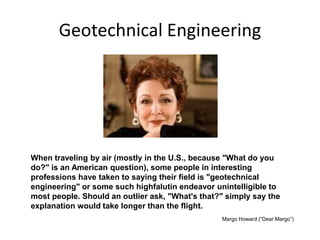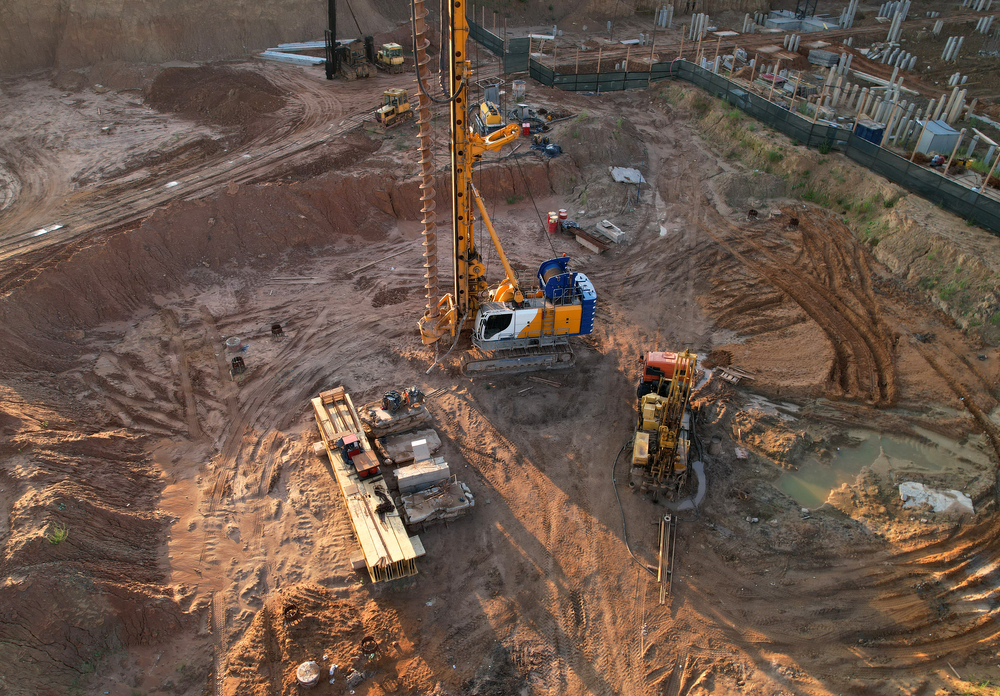The Buzz on Geotheta
Table of ContentsSome Known Incorrect Statements About Geotheta Some Known Details About Geotheta Everything about GeothetaThe Buzz on GeothetaNot known Facts About Geotheta

They perform site investigations, gather examples, execute lab examinations, and assess data to assess the viability of the ground for construction tasks - Tailings Engineer. Based upon their searchings for, geotechnical designers provide recommendations for foundation style, incline stability, preserving frameworks, and mitigation of geotechnical hazards. They work together with various other professionals, such as engineers, structural designers, and building and construction groups, to make certain that geotechnical factors to consider are incorporated right into the total task layout and execution
By assessing the behavior and buildings of dirt and rock, they can recognize possible geotechnical dangers such as landslides, dirt settlement, or slope instability. Their competence assists protect against failures or accidents that can jeopardize lives and home. Here are some comprehensive responsibilities and duties of a geotechnical designer: Website Examination: Geotechnical designers conduct website investigations to gather data on subsurface problems.
They translate the data to recognize the properties and behavior of the dirt and rock, including their stamina, leaks in the structure, compaction qualities, and groundwater problems. Geotechnical Evaluation and Style: Geotechnical engineers assess the information collected throughout site examinations to examine the stability and suitability of the site for building jobs. They perform geotechnical computations and modeling to review factors such as bearing capability, settlement, incline stability, lateral planet stress, and groundwater circulation.
The Definitive Guide for Geotheta
Foundation Layout: Geotechnical engineers play an important function in making structures that can securely support the designated framework. They assess the dirt conditions and tons needs to identify the ideal structure kind, such as superficial foundations (e.g., grounds), deep structures (e.g (https://www.goodreads.com/user/show/180594840-ian-hammond)., piles), or specialized methods like dirt enhancement. They consider variables such as settlement restrictions, bearing capacity, and soil-structure communication to create ideal structure styles
They examine building plans, monitor website activities, and carry out area inspections to verify that the layout recommendations are complied with. If unforeseen geotechnical problems arise, they evaluate the circumstance and provide recommendations for removal or adjustments to the design. Risk Analysis and Mitigation: Geotechnical engineers evaluate geotechnical dangers and threats connected with the project site, such as landslides, liquefaction, or dirt disintegration.

Cooperation and Interaction: Geotechnical designers function very closely with various other experts associated with a task, such as designers, structural designers, and building groups. Efficient interaction and partnership are important to integrate geotechnical considerations into the total task style and construction procedure. Geotechnical engineers supply technical proficiency, solution questions, and make sure that geotechnical requirements are fulfilled.
Excitement About Geotheta
Below are some sorts have a peek at this site of geotechnical engineers: Foundation Designer: Foundation engineers concentrate on designing and evaluating foundations for frameworks. They analyze the soil conditions, load requirements, and site features to determine the most ideal foundation type and style, such as superficial structures, deep structures, or specialized strategies like heap foundations.
They evaluate the aspects affecting incline security, such as dirt homes, groundwater conditions, and slope geometry, and establish methods to stop incline failings and minimize threats. Quake Designer: Earthquake engineers specialize in evaluating and creating structures to endure seismic forces. They evaluate the seismic hazard of a site, evaluate dirt liquefaction possibility, and establish seismic style criteria to ensure the safety and resilience of frameworks throughout earthquakes.
They carry out field screening, accumulate samples, and evaluate the collected information to characterize the soil properties, geologic developments, and groundwater problems at a site. Geotechnical Instrumentation Engineer: Geotechnical instrumentation designers focus on monitoring and gauging the actions of soil, rock, and structures. They mount and preserve instrumentation systems that monitor aspects such as soil negotiation, groundwater levels, incline motions, and architectural displacements to analyze performance and give very early warnings of possible issues.
Geotheta - Truths
They perform tests such as triaxial examinations, debt consolidation tests, direct shear examinations, and permeability tests to collect information for geotechnical analysis and style. Geosynthetics Designer: Geosynthetics designers specialize in the style and application of geosynthetic products, such as geotextiles, geogrids, and geomembranes. They use these materials to boost soil stability, reinforce inclines, give drainage options, and control disintegration.
They often tend to be investigatory people, which suggests they're intellectual, reflective, and inquisitive. They are interested, systematic, sensible, logical, and sensible. Some of them are additionally social, meaning they're kind, generous, participating, individual, caring, practical, understanding, sensible, and pleasant - Geo Tech Engineering.
In the office atmosphere, geotechnical engineers use specialized software application tools to perform calculations, develop styles, and evaluate data. They prepare records, testimonial job specs, communicate with customers and staff member, and coordinate project activities. The office setup provides a conducive setting for study, analysis, and partnership with other experts associated with the job.
Little Known Questions About Geotheta.
They often visit task sites to conduct site investigations, evaluate geotechnical conditions, and collect information for evaluation. These brows through entail taking a trip to various places, sometimes in remote or challenging surfaces. Geotechnical designers may do soil sampling, conduct examinations, and monitor building activities to make sure that the geotechnical facets of the job are being applied correctly.
Geotechnical designers also operate in specialized geotechnical labs. In these facilities, they carry out experiments, execute examinations on soil and rock samples, and assess the engineering residential or commercial properties of the materials. Geotechnical research laboratory designers work thoroughly in these settings, handling testing devices, operating instruments, and tape-recording information. They work together with various other research laboratory staff to guarantee precise and reliable testing results.